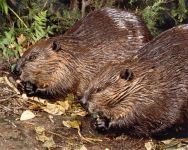


|

|
|
 
|
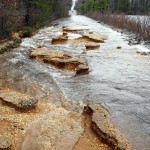
I don't know if you all remember the torrential rain storm that I wrote about in the July 2007 Beaver Defenders. On April 15th, South Jersey received approximately 12" of rain in a twenty-four hour period. Dams, roads and bridges throughout the area were blown out by swollen streams and rivers. Unexpected Road was breached when the force of the water scoured out a huge crater in the roadbed, spewing dirt and stone hundreds of yards into the woods. Main Pond immediately began to drain as a result, and our brave beavers hightailed it out of there and relocated up into Main Pond. Many people suffered flooding when dams gave out, forcing them from their homes, like our beavers. Many lawsuits against damowners followed! Thankfully, no one downstream was flooded by our waters – this tributary of the Great Egg Harbor River flows into the Cedar Lake Wildlife Management Area in Monroe Township.
Since that fateful day, Miller Pond has been verdant marsh meadow decorated with a Pinelands stream meandering through it like a coffee-colored ribbon. This expansive green vista is filled with cattails, sedges and wild flowers that bend and sway in the wind. Herons, eagles and redwing blackbirds stalk, perch and fly across the soft gently moving blanket of vegetation. But no beavers live there.
After the rain stopped, Buena Vista Township came to the rescue, repairing the broken bank with sheet piling. However, in addition to the breach, the old wooden spillway under the bridge had failed. By the end of the month, the pond was gone for good. Instead of holding back the water, the spillway allowed it to escaped beneath the structure. This situation made it physically impossible for our beavers to build an effective dam. Miller Pond became a memory.
However, one must try to think like a beaver. If the bridge and spillway were removed, the stream would flow freely across the abandoned road. An IDEAL spot for a beaver dam!
The township and county both got on board when I suggested that we not fix the road (which would have cost the taxpayers almost $1,000,000 for a road design that would NEVER impound water). We decided in the best interests of all those involved – the Refuge, the township, the county, the taxpayers and the beavers – to vacate Unexpected Road. That means the township gives up ownership of a road to whomever owns the land on either side of the road. Since the Refuge is the landowner on either side of Unexpected Road, the land would revert to Refuge ownership. We would then make the road part of our trail system, available for all to enjoy. We had an engineer design the bridge deconstruction plans and began the long slow process of getting the necessary permits from the State.
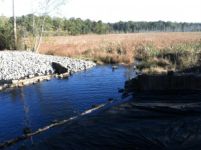
Finally, six years later, the Atlantic County and Buena Vista Public Works Departments began removing the bridge decking, guardrail, spillway and pilings per the approved plans. Thankfully, much of what was removed was recycled for other uses by both departments. At this point, all existing materials have been removed and the roadbed has been graded down to the stream. They spread stone rip-rap to prevent erosion on the slopes, and now the stream flows freely, unimpeded. Just like the plan! All we need to do now is drop large boulders at intervals across the water so hikers can hop across. We eagerly wait for spring, when the young beavers venture out looking for new homesteads. Miller Pond has always been a smorgasbord of culinary delights for our beavers, so it is only a matter of time.
Speaking of beavers... Susan Russell, APLNJ Wildlife Policy Director, gave me an update on the horrendous Beaver Bill that was explained in the last issue of The Beaver Defenders. She says that Senator Bob Smith (D17) wrote the League of Humane Voters regional director Merrilee Cichy, that he will not be hearing the beaver bill in the Senate Environmental and Energy Committee. So it is thought that the bill is dead for the time being. Thanks to all of you who took the time and effort to contact your representative to protest this bill. We may have to do it again, so I will keep you posted!
Thanks also to those of you who gave that little extra for the new septic system. We have the money we need, and we have contracted with East Vineland Construction to do the work. Unfortunately, we will have to hold off on the actual installation until deer season is over due to increased traffic in and out for patrolling. If you have ever been back here, you know that our half mile-long, one-lane dirt driveway is daunting as it is, with very little room for maneuvering. The septic system installation will involve movement of equipment, dirt fill, stone and piping in and out of the site, so we will wait until things calm down before we start that process. We received grant money from our longtime supporters Chemglass, The Binky Foundation and of course, Conservation Resources, Inc. Just a shout out to the gang at CRI who have embarked upon a new adventure at Duke Farms in Hillsboro, NJ. Thank you so much to Michael, Jon and Julie for all the technical, financial and moral support over the years. I could never have done so much, so well, without your help. Best of luck!
The dog days of summer – that pretty much sums up where we are right now. Historically, these days occur in the northern hemisphere between early to mid-July and early to mid-August when the temperature and humidity both skyrocket. This tag has been used since the early Egyptians associated these days with the star Sirius, the Dog star, which rose with the morning sun. I call them dog days because my dogs pant a lot right now.
So far, this summer has been extremely hot and muggy with a lot of rain. The beavers have moved upstream and are not being very social, even for apple bribes. They continue to visit the Dike every night and wreak havoc on the boardwalk, stuffing mud and sticks into every crevice, causing the whole walkway to be rather treacherous. I am seriously thinking about putting my money where my mouth is, so to speak, and installing a flow device to alleviate this chronic battle.
Afternoons are still and heavy with cicadas calling and the occasional loud CRACK, the startling report from a walnut hitting the barn's metal roof. The air is thick with dragonflies and butterflies. We have clouds and clouds of swallowtails fluttering about, especially spicebush swallowtails. They congregate in groups of up to twenty, harvesting minerals and salt from the vilest of substances in the driveway. They explode in a burst of color when the dogs charge them.
At night, walking down a dark swampy path is a magical treat. Thousands of fireflies blink on and off in the damp bushes. There are about two thousand species of fireflies in the world. Some are nocturnal and use bioluminescence to signal for mates or prey. Others are diurnal, or active during daylight hours, and do not light up at all. They use pheromones and the sense of smell to find what they are looking for. In some locations like Elkmont, TN or the Malaysian jungles, a phenomenon called phase synchronization takes place, whereby all the fireflies fire their lanterns at the same time. That must be a sight to see, but here we just have their romantic twinkling party lights in the dark forest.
Success at last – Several years ago we entered the Codario Farm into WHIP, USDA Farm Service's Wildlife Habitat Incentive Program, to benefit ground-nesting birds. It was a rough start, actually two if you remember. After the second seeding with little and big bluestem and woolgrass, the plants took off with four to six foot plants. Beth Ciuzio, of the USFWS, identified a rare grasshopper sparrow on the site in June. We also have a nesting killdeer on the property. Grassland birds have taken a hit due to loss of habitat, so this is great news.
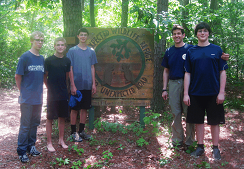
Eagle Scout #11 – We had another successful Eagle Scout project here in June. Craig Giangiolio, Boy Scout Troop 65, Haddonfield, designed, built and supervised the installation of six wood duck boxes around Main Pond. Wood ducks are very beautiful, especially the boys – they have an iridescent green head with black cheeks, white stripes and red eyes. With a dark back, buff colored sides and a chestnut breast, these ducks are striking to say the least! The girls, as usual, are much duller with a distinctive white ring around each eye. Female wood ducks have a piercing cry when flushed from the water. Wood ducks live and feed in wooded swamps and nest in tree cavities over, or near, open water. They have strong claws that allow them to grip branches and bark on trees and logs. The wood duck boxes that Craig constructed have wire "ladders" on the inside below the hole to give the youngsters a little help getting up and out when the time comes. Wood ducklings are precocious, which means that once mom calls them out of the nest and into the water they stick close to her and never return to the nest.
Craig installed the boxes on galvanized poles complete with predator guards in order to keep out snakes, raccoons and other unwanted guests. Many thanks to Craig and his crew for helping to provide housing for these beautiful, elegant and engaging waterfowl.
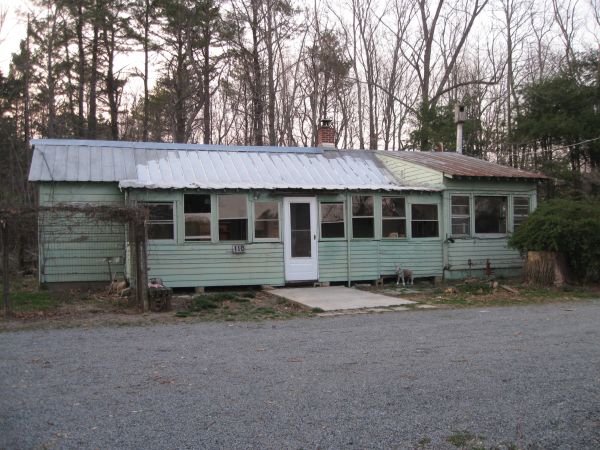
Phased Construction – Many of you may remember the new LEED Headquarters we dreamed up about two years ago. Well, we priced it out for construction, and it came in at about $650,000. Wow, is that a lot of mugs and T-shirts! Since we don't have that kind of funding just lying around, we are tackling it in phases. We previously received grant money to do some site preparation work like driveway improvements and tree removal around the cabin. Now we have to address the ancient septic system. We have approval from the Atlantic County Health Department to install a new system and have selected a contractor. Grant money from our friends at Conservation Resources Inc., The Binky Foundation and Chemglass will help put us on the throne, so to speak. If you would like to contribute toward this project, just add a little extra to your dues check with a note on the memo line, "septic project." You can help us get a straight flush.
Here is where we are going – We had fabulous feedback from the last issue, when we discussed switching from paper to electronic format. It was overwhelmingly evident that it is time to go paperless. Not to worry for those of you who do not have access to the internet or just prefer to hold the real thing in your hand. We can continue to accommodate you with paper copy if you specify your preference. In order to make this a very smooth seamless transition, please fill out your membership form in the back of this issue completely. July was renewal month, and I thank those of you who remembered to send in your dues, and a very special thank you to those who gave extra. It really does help! And remember we have that PayPal button on our website, quick, easy and again, PAPERLESS!
For the sake of closure, I have decided to finish this year's publication in paper, so you will get one more hard copy after this one; the fall issue. The New Beaver Defenders came out in January 2003, so you will have gotten a decade of this newsletter in the mail. Please don't forget to send me your email address with your dues, and your first paperless issue will be Winter 2014, when we turn over a new leaf.
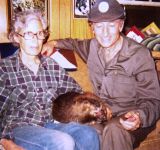
Something to ponder... Back in 2003, I resurrected The Beaver Defenders, a publication that my predecessor began back in the early ‘70's. Hope's wonderful newsletter evolved from a news sheet she used to tap out on her typewriter every month called "Good News", whereby she would share nature experiences with her friends. When she and her family moved to the Refuge and found beavers living here, they began the fight to ban the leghold trap in New Jersey, and she founded The Beaver Defenders to spread the word and elicit support.
In 1999 when she fell ill and could no longer write and edit the newsletter, Hope folded her membership into Beavers: Wetlands & Wildlife's newsletter Beaversprite, out of Dolgeville, New York. Her wish was that eventually TBD would come back to Unexpected. Fortunately, it did happen; unfortunately, not before her passing.
This is our 45th issue of The (new) Beaver Defenders, and I think it is time for us to sit back and think about where this newsletter is going (or rather, not going). Hard copy news publications are on the way out; most are losing readership, membership and money. Ours is no exception. Although I get wonderful notes from some of our oldest and most dedicated members, sometimes I wonder if this newsletter goes on that pile that we all have – the "I will look at that later pile." Life gets busy and sometimes the next issue comes and still the last sits there, taunting you. I know I feel guilty about all that paper waiting for me.
It takes monumental time and effort to put the paper together, and printing and postage costs have skyrocketed. It costs over $3,800 a year to send out this publication; money that could go toward more land – it is not a lot of land, but it is strategically located and not too pricey. Or toward a new septic system, or toward funding the construction of our new facility.
I do not want to increase the price of membership, so I reduced the number of pages in each issue since last printing. But is that a solution?
I need some feedback from you. Where do you want to see your newsletter go? Do you want to read it on line? Did you know we have a website? With a Paypal button that saves a stamp when you make a contribution or pay dues? We don't twitter, chatter, ping or pop, but we do have a Facebook page! Do you care? Some don't. Would you like to get weekly updates via Facebook or email? Some do.
July is renewal month for membership. Please give some thought to what you would like to see happen here and include your ideas with your renewal information. Or send me an email with your on-line donation through Paypal. Save a stamp.
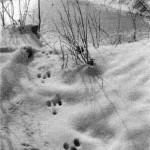
MAKING TRACKS. As the old adage goes, take only pictures and leave only footprints. Recently, we got a little snow (far too little for me) – two inches one night, then a dusting two nights in a row with accompanying sub-zero temperatures, so it was a winter wonderland here at the Refuge for a bit. The first week of February lead me down some interesting paths. I wandered out of the house on a frozen morning to briefly check on the wood pile and found myself an hour later deep in the woods following tracks.
When I explain to others the reason the Refuge was created, I often get a perplexed look of disbelief that its primary mission is to "provide an inviolate sanctuary for indigenous plants and animals of the Pinelands." Or something to that effect. Basically, any creature within the boundaries of this haven is safe from persecution of any kind.
What? Just for animals and plants? It wasn't a playground made for humans to use? The by-product of this first function allows well-behaved humans to explore and enjoy the refuge through passive recreating. Taking only pictures and leaving only footprints.
Being one of those well-behaved bipeds (most of the time) I was delighted to be doing just that in the cold slanting shafts of brilliant morning sunshine. Using my identication books, I read the footprints left in the snow like sentences on a page. They told many different, but interconnected stories of intrigue, adventure, danger and delight, all written by different authors. Time warped as I tried to reconstruct the past.
The clouds pushed through abruptly and under a low leaden winter sky. I walked along a snowy path cradled on one side by a forest of large, dark bare trees bent protectively overhead, and on the other by soft reddish bushes that fringed the frozen crusty pond. Surrounded by evidence of winter follies and forays, the story was written before me. Rabbit and squirrel tracks interlaced at the trail head where the open grassy slope squeezed down into a moss and snow mottled linear strip. The prints crisscrossed each other in an intimate chain, though the explorers probably never saw each other. As I walked along watching, listening and poking around, tiny sparrows darted in and out of the low, lacy brush along the icy shore, delicately picking hidden seeds from the dry grasses, fluttering and floating just steps ahead of my heavy snow boot pace.
Evidence of a fox appeared on the path from the ice. I followed his tracks back to find that he had comeacross the frozen pond from the north. Once on the path, he trotted here and there smelling his own story, nosing and digging into the cover, looking at the same tracks that I was now reading – those of his unsuspecting prey; but perhaps they had been onto him the whole time.
frozen beaver dam, there was a 12" diameter hole in the ice where an otter had broken through to come topside. The dark water lapped at the jagged edges of ice. The unseen current was swift below me, below the white stillness where I stood. Gazing upstream, I could see other holes, every hundred feet or so, where she had popped up to look around and get air. Her tracks at this hole showed where she had slipped up and out of the frigid water, slid along the snow and glided out onto the open ice. It looked like she had been playing hockey, slipping and sliding her own personal rink. Otters always know how to have a good time.
The path curved away from the open pond, and as it traversed deeper into the quiet forest I met a small flock of gregarious ruby crowned kinglets. Their sweet demeanor allowed me within arm's reach of where they were dancing in and out of the laurel and high bush blueberry plants. Under the protection of the quiet winter woods, I found and followed turkey, raccoon and opossum tracks (which look like little stars). I think, according to the field guides, I followed a skunk for awhile, as well as a small herd of very lucky deer who made it through hunting season.
I didn't see that our beavers had been out after that snowfall, but I could see the new sturdy white outline of their homestead far upstream. Local beavers have been busy elsewhere this winter, though. We were called back to both Wenonah and Haddonfield to consult on beavers damming and flooding conservation areas in the Mantua and Timber Creek watersheds, respectively. Fortunately, after conferring with us, both municipalities have decided to install ow devices instead of trapping out the resident beavers.
Haddoneld's conservation area at Crow's Woods got their busy beavers back. Several years ago, the damming and flooding problem was solved by extending the length of the wooden boardwalks to accommodate the extra water. But now their new dams are causing problems for a neighboring golfcourse at the 16th hole pond. We met with the city Commissioners, the golf course and our old friend Butch Brees and came up with a brilliant idea. The golf course will fund a flow device installation in Crows Woods which will be built and installed as an Eagle Scout project for a Boy Scout in Troop 65. We, of course, will consult. Win, win, win, win, win. I think that's how many wins we get out of this project. I guess in this instance we will take only pictures and leave only piping.
Thank You for Another Year of Patrol!
Yet one more deer hunting season concluded in zone 25 with the close of January. The weather was kind to us patrollers this year, with warm days and cold nights, very little precipitation, and thankfully we had no incidents to speak of and no injuries to report. Thanks to Maryann, Dave, Judy, Jan, Paw'La (who was baptized that day – brrrr), Chris, Pat, Candy, Greg, Julie, Jenn, Julian, George, Leona, Theresa, Bob Jean, Dave, and Gene. Extra special thanks go to those who gave extra rounds: Moe, Freya, Anne, Clint, Roger, and Jummy. The time you volunteered, the concern you share, and the support you provide to the Refuge is so very appreciated. Each and every one of you has a special place in the heart of the Director.